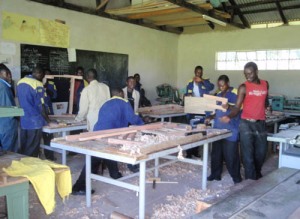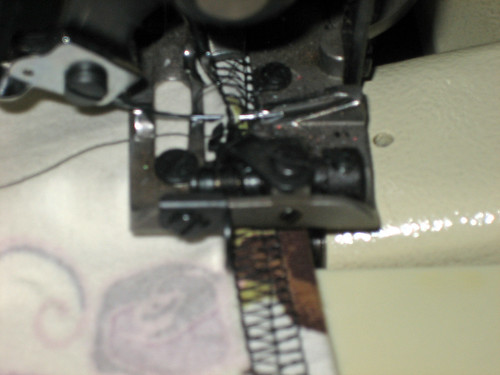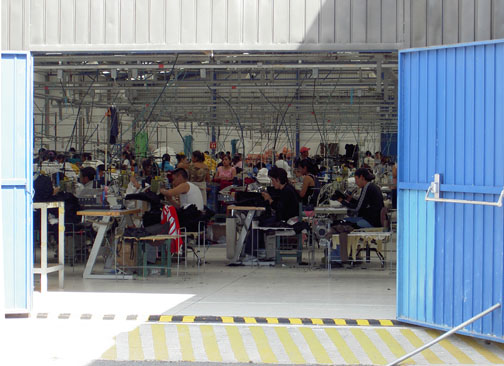Last month my HB and I were traveling in Kenya for 3 weeks and I was lucky to visit a dressmaker’s class in Mago, a small village in Western Kenya.
The Dressmaking/Tailoring class is a department of a Polytechnic school that was built and financed in 2005 by some Dutch people.
We stayed for 6 days in the guesthouse http://www.magoguesthouse.com/
The stay in the guesthouse  provide the needed income for the school. Our oldest son is doing an internship for 6 month there together with his girlfriend Linda, as part of their final year of study of Tourism and Management. They will do the marketing and manage the guesthouse .
provide the needed income for the school. Our oldest son is doing an internship for 6 month there together with his girlfriend Linda, as part of their final year of study of Tourism and Management. They will do the marketing and manage the guesthouse .
The Catering & Hospitality students provide services at the guesthouse .
Our son went to South Africa last April to do some shorter studies and internships at a school in Port Alfred for his Tourism and Management major. He bought a Toyota Hilux 4×4 and has driven the old jeep through Swaziland, Tanzania, Lesotho, Zambia, Botswana, Malawi, Mozambique, Zanzibar to Kenya where he started his internship late August and we have missed him terribly. It was a joy to see him again and to see where he is working now.
The polytechnic school has several departments for students (age 18-28) to get an education for 2 years in Motor Vehicle Mechanics, Carpentry & Joinery, Building & Construction , and Tailoring & Dress making.





I knew beforehand that the school had a dressmaking/tailoring class so I stuffed some possible hard to get fabrics like stretch lace, sewing notions, books: Fit for real people , Sew Any Patch Pocket, Sew Any Set-In Pocket and some pattern magazines like Burda, Knip and Diana in my suitcase.
I had the pleasure to see the students at work and was welcomed by the teacher and students as a colleague dressmaker.
There are 36 students in the dressmaking class and they learn pattern drafting and sewing.
The students learn to sew and make samples not using muslin fabric but they draft a pattern on brown craft paper and learn to sew that paper garment made on ½ scale and this way they learn to know which steps are going to be sewed first.
The students are working in two classrooms, one is for the theory and the other classroom has 24 beautiful Singer treadle machines.


I spend a day at the Dressmaking/tailoring School and shared some sewing techniques, for example I made a sample of a bound buttonhole on a treadle machine that was for me a new experience, since I am used to an electric sewing machine.
I have some vague remembrance of sewing once on a treadle machine in grammar school but since that did happen a long way ago I felt such a beginner sewing on such a machine.
The Singer machines they use are beautiful and well-maintained.
All the dressmakers/tailor shops I saw when we drove through the villages in Kenya are using treadle machines since only a few people are lucky to have access to electricity.
The Dressmaking/Tailoring School is well equipped by Kenyan standards but they could use some better scissors and from my point of view more notions as I happened to find out when I needed to use scissors for cutting some fabric.
As a dressmaker I know that good tools are such a pleasure to work with and will make the sewing part so much more enjoyable.
I tried to find a notion/sewing store in the big cities like Nairobi and Mombasa but I could not find even one.
So once we were home again after our fantastic 3 week vacation traveling in Kenya, I was planning to do some serious shopping for the dressmaking/tailoring class.
I told my parents and sister about my shopping plan and they spontaneously donated money too, so I could buy 36 scissors, thread nippers and seam rippers, plus a large dressmakers shear and pinking shear, plus some other notions which I thought they could use.

I had some red upholstery leather in my stash from an old leather couch once owned by my sister so I made sheets to protect the scissor blades and made an extra pocket so the seam ripper and thread nipper were all in one place.


It was a lot of work but fun to make since I knew beforehand that those notions would be for a good cause.
Since it is very expensive to ship the 5-kilo scissors to Kenya I was very lucky to find out from one of the Dutch founding member of the board (who started and finance the school)that friends of him would travel to Kenya and could pack the scissors in their suitcases.
So the 165 km drive to another town to hand out the scissors was well spent and was cheaper than shipping with no worry that the scissors could get lost during shipping. The scissors were accepted with great appreciation and will help the students to accomplish their work to become a dressmaker/tailor and start a dressmaking business to earn a living.
The other notions, dressmakers ham and pattern book Modelling and Flat Cutting for Fashion by Helen Stanley are traveling with the parents of my son’s girlfriend Linda who are leaving tomorrow for their Kenya vacation.
I wish I had the opportunity to do some volunteer work at the Dressmaking/Tailoring school but since that will not be possible I was happy that our family could donate some needed tools to make sewing much more enjoyable and pleasant.

 And guess what happened? Well, my ancient (2001) Bernina 180E Artlink software is not compatible with any of the five computers we have in this house. I didn’t want to shell out $500+ to Bernina for their true editing software because I don’t use the embroidery module all that much, and who the heck knows if it would even work on a Bernina machine from 2001 and a 2007 PC running Vista. Intense frustration ensued.
And guess what happened? Well, my ancient (2001) Bernina 180E Artlink software is not compatible with any of the five computers we have in this house. I didn’t want to shell out $500+ to Bernina for their true editing software because I don’t use the embroidery module all that much, and who the heck knows if it would even work on a Bernina machine from 2001 and a 2007 PC running Vista. Intense frustration ensued.






















 Subscribe with Bloglines
Subscribe with Bloglines